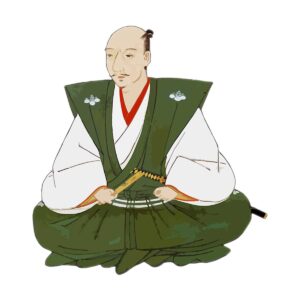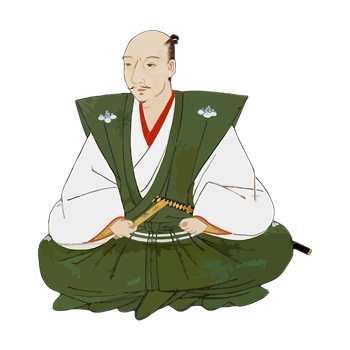
The relationship between the ceramic industry and Nobunaga includes the use of Ming-style tiles during the construction of Azuchi Castle and the influence on tea ceremony utensils, but what is particularly noteworthy is his protection policy for the ceramic industry in Owari and Mino (Aichi and Gifu prefectures).
The Nobunaga’s “seifuda” and “shu-in” (red seal) letters found in various documents are evidence of his protection of the pottery industry, breaking away from the traditional mercantilist approach.
Nobunaga’s Seifuda,” which is a seal of Nobunaga, is kept in many houses in the Seto area to prove that the family is an old family, but the true Seifuda is in Kato Shinemon’s house in Shinano, Seto City.
The text reads
Seifuda, Seto
The following is a list of the things that are not allowed to be sold in Seto
The following is a list of things that are not allowed to enter the country, including white bales of goods and salted goods from Seto.
(2) The taking of pledges from the various officials of the renewal ceremony is prohibited.
Those who violate any of the articles listed on the right shall be swiftly punished.
December 1563, Eiroku 6 (1563)
The following three articles were stipulated: merchants from various villages engaged in the Seto business are free to come and go as they please throughout the country; grain and marine products are free to enter and leave the Deai market in exchange for Seto products; on the day the market is open, merchant horses are prohibited from passing through side streets to avoid the market; and no new taxes, local pledges or pledges may be levied on the merchants. If any of these three articles were violated, the owner would be promptly punished and punished.
Shirobawaraimono are substitute bales of grain and other bales to be exchanged for settlements.
Shioaimono is a generic term for salted fish, which is today’s isabamono (dried fish, etc.).
According to the theory of Shuko Miura, the term “gozoku” or “tokyozoku” refers to a contract between a creditor and a debtor, under which the creditor agrees that if the debtor fails to pay his debts, his property may be seized as soon as he finds it, regardless of time or place, and the seizure is executed.
A manuscript from the early Tempo period (1830-44) titled “History of Seto Kilns” states, “From the middle of the Bunsei era, both the seifuda and the certificate were presented at the New Year’s gathering of kiln makers at Ohimachi, with sake and snacks served to the visitors, However, since some time ago, both of them have kept them as if they belonged to their own families and have not shown them even at New Year’s since then.
The present Shin’emon is the grandson of Shigogo V.
The copy has an error in Article 3, where the word “0000gyo pawnshop quality” is mistaken for “gyo-yen tosho yen,” and in the last sentence, the word “Ran” is mistaken for “Ran,” and one character for “day” under “December” has been omitted.
The manuscripts in the collections of old Seto families, such as “Honcho Toki Zusho”, “Wahari no Hana”, “Seto Town Journal”, “Toki Ruishu”, “Nihon Toki Shi Ron”, “Higashi Kasugai Gunshi”, and “Nihon Toki Jigashi” all contain the same errors.
It is likely that the person who originally copied the letter changed it due to a lack of knowledge about seifuda, and that this was gradually passed on to a wider audience.
The red seal of Nobunaga” is in the possession of the Kato Hikoshiro family of Tajimi City, Gifu Prefecture.
Seto pottery kettle
The first rule of the matter is that he must be the first.
The Seto pots can be fired in any other place.
No other pots are allowed to be made elsewhere.
It is impossible for them to be inseparable.
Tenkoshiki
New Year’s Day 11th Nobunaga (red seal)
To Shiga Tozaemon.
The letter is accompanied by a document dated 1722 (Shoutoku 2) that describes its transmission.
According to the letter, Ichizaemon lived in Akazu and then moved to Seto, where he made a tea pot and presented it to Nobunaga in the first month of 1574, who gave him a red seal as a reward. He is said to have changed his name to Yosanbei Kagemitsu.
According to an old manuscript titled “Setogama Denkaku Ki,” Ichizaemon fled to Kusjiri in 1583 (Tensho 10), and the red seal was later transferred to Tajimi, but in 1792 (Kansei 4), when the potters of five villages in Seto, Akazu, Shinano, Tajimi, and Kusjiri claimed to be relatives and started a meeting for New Year holidays, they brought out this red seal, The agreement was to deposit the red seal for one year at a time in the village in charge, and this continued for about ten years, but for some reason it was later discontinued, and the red seal remained in Tajimi.
The letter of exchange between the five villages at that time still remains.
The relationship between tea ceremony utensils and Nobunaga, who fell as the middle road to conquer the country, was that he viewed tea ceremony utensils and the tea ceremony as an intermediary between war, politics, and economics.
In 1568, when he defeated Hisahide Matsunaga and appointed Yoshiaki Ashikaga to the shogunate, he had Hisahide deliver an eggplant crop and Munehisa Imai, a political merchant in Sakai, deliver a Matsushima pot and an eggplant from Shao’ou, and the following year, as a “hunt for famous items”, he took items such as hatsuka hagashirazu, Fuji eggplant, turnip without flowers, and painted geese from various powerful families in Rakuchu. In 1570, he ordered Matsui Tomokan, a deputy governor of Sakai, to collect local specialties, and after viewing them, he took from among them a picture of Soguryo sweets, a Yakushi-in Komatsushima jar, a Josyu citrus vase, a Ryoun coin-shaped vase, a Sokuyu Kaisan Gotoku, and others.
He also received a Senkasu incense burner from Ujimasa Imagawa, a pair of three kettles from Kennyo Shonin of Ishiyama Honganji Temple, and a 3-day moon vase from Yoshihon Miyoshi.
Nobunaga also gave these tea utensils to his subordinates for their achievements and licensed the tea ceremony.
In 1578, Hideyoshi and others received the Gozen no kettle and a painting of the moon as a reward for their achievements in Banshu Keisoku.
Takigawa Kazumasa, who was appointed to the Kanto region as a reward for defeating the Takeda clan and was given the town of Umabayashi in Jyoshu, is said to have been saddened that he had wanted a Jukou konasu tea bowl even if it cost him the whole country.
These things were called “chayu seido” by Nobunaga.
It is said that the reason for this was to hold a tea ceremony with his treasured tea utensils in accordance with a previous agreement with Shimai Soshitsu, a tea master in Hakata, who was to hold a tea ceremony with his treasured tea utensils.
Later, he built a teahouse in Azuchi Castle with Munehisa Imai, Munenori Tsuda, and Soyui Sen from Sakai as tea masters, and also held tea ceremonies at Shokokuji, Myokoji, and Myokakuji temples in Kyoto.



